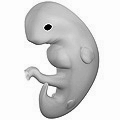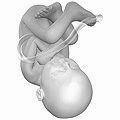
Prenatal development is divided into two primary biological stages. The first is the embryonic stage, which lasts for about two months. At this point, the fetal stage begins. At the beginning of the foetal stage, the risk of miscarriage decreases sharply, all major structures including hands, feet, head, brain, and other organs are present, and they continue to grow and develop. When the fetal stage commences, a fetus is typically about 30 mm (1.2 inches) in length, and the heart can be seen beating via sonograph; the fetus bends the head, and also makes general movements and startles that involve the whole body. Some fingerprint formation occurs from the beginning of the fetal stage.
Electrical brain activity is first detected between the 5th and 6th week of gestation, though this is still considered primitive neural activity rather than the beginning of conscious thought, something that develops much later in fetation. Synapses begin forming at 17 weeks, and at about week 28 begin multiply at a rapid pace which continues until 3-4 months after birth. It isn't until week 23 that the fetus can survive, albeit with major medical support, outside of the womb. It is not until then that the fetus possesses a sustainable human brain.
Embryo at 4 weeks after fertilization Fetus at 8 weeks after fertilization
Fetus at 18 weeks after fertilization Fetus at 38 weeks after fertilization
(simplified illustration)
Relative size in 1st month Relative size in 3rd month
Relative size in 5th month Relative size in 9th month







